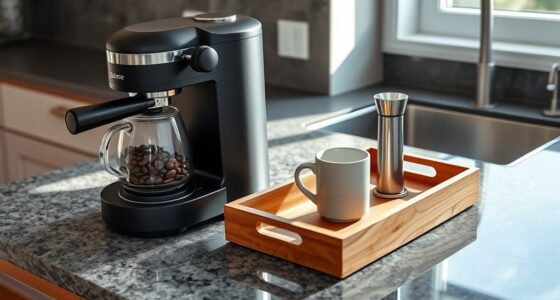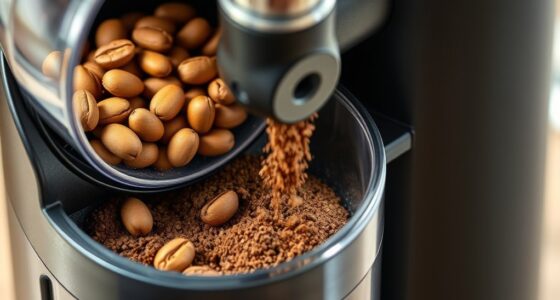Cheap knock boxes may seem budget-friendly, but they hide issues like poor materials that break or warp quickly, creating safety hazards and frequent replacements. Cleaning can be a hassle because residue builds up and cracks develop, making maintenance tough. Poor design leads to spillage and mess, while instability and loud noise disrupt your workspace. Small fixes and upgrades can improve durability and hygiene—if you want to find out how, keep exploring.
Key Takeaways
- Low-quality materials in cheap knock boxes wear out quickly, risking breakage and safety hazards over time.
- Poor sealing and porous surfaces make cleaning difficult, leading to residue buildup and hygiene issues.
- Inadequate design causes spillage and unstable use, increasing mess and reducing efficiency.
- Cheap knock boxes tend to be noisy and unstable, disrupting quiet environments and posing safety concerns.
- Frequent replacements due to material fatigue result in hidden costs and decreased overall durability.
Durability Concerns and Material Quality

While cheap knock boxes may seem like a budget-friendly choice, their durability often leaves much to be desired. The material quality used in low-cost options typically isn’t designed to withstand frequent use, which impacts the product’s longevity. Thin or brittle materials can crack, warp, or break after only a few weeks of use, forcing you to replace the entire box sooner than expected. Poor-quality metals or plastics won’t stand up to the repeated impact of knocking espresso grounds, leading to faster wear and tear. Investing in a higher-quality knock box means better material choices that resist damage and maintain their shape over time. This not only extends the lifespan of your equipment but also saves you money in the long run by avoiding constant replacements.
Challenges With Cleaning and Hygiene

Cheap knock boxes often accumulate stubborn residue that’s hard to remove. You might find that cleaning them thoroughly takes more time and effort than expected. This can lead to hygiene issues if you don’t perform regular, careful sanitation. To improve their cleanliness and maintain hygiene, consider proper cleaning techniques that target difficult residues more effectively.
Buildup of Residue
Residue buildup is a common challenge when using knock boxes, especially those made from lower-quality materials. Over time, coffee grounds and used puck remnants stick to the interior, making cleaning more difficult. This residue buildup can lead to unpleasant odors and impact hygiene. Because cheaper knock boxes often have porous surfaces or poorly sealed seams, removing stubborn deposits becomes a frustrating cleaning challenge. If not addressed regularly, the residue can harden, requiring extra scrubbing or soaking. Additionally, the accumulation of old coffee grounds can harbor bacteria, compromising sanitation. To prevent these issues, you need to clean your knock box frequently and effectively. Using proper tools and cleaning solutions can help manage residue buildup and keep your equipment hygienic and functional. Understanding the importance of materials and design can help in choosing a more durable knock box that resists residue buildup.
Difficult Sanitation Procedures
Cleaning a knock box with difficult sanitation procedures can be a tedious task, especially when grime and coffee oils cling stubbornly to its surfaces. These sanitation challenges make cleaning more time-consuming and frustrating. The design of cheap knock boxes often lacks smooth surfaces, trapping debris and requiring extra effort. Imagine trying to scrub a container with these features:
| Surface Type | Cleaning Difficulty | Residue Trapped |
|---|---|---|
| Textured | High | Yes |
| Sharp Edges | Moderate | Sometimes |
| Flat Surface | Low | Rarely |
The more complex the surface, the harder it becomes to remove stubborn coffee oils and residue. This increases cleaning difficulties, making hygiene maintenance less efficient and more labor-intensive. Additionally, difficult sanitation procedures can contribute to the growth of bacteria if not properly cleaned, posing health risks.
Poor Fit and Spillage of Used Grounds
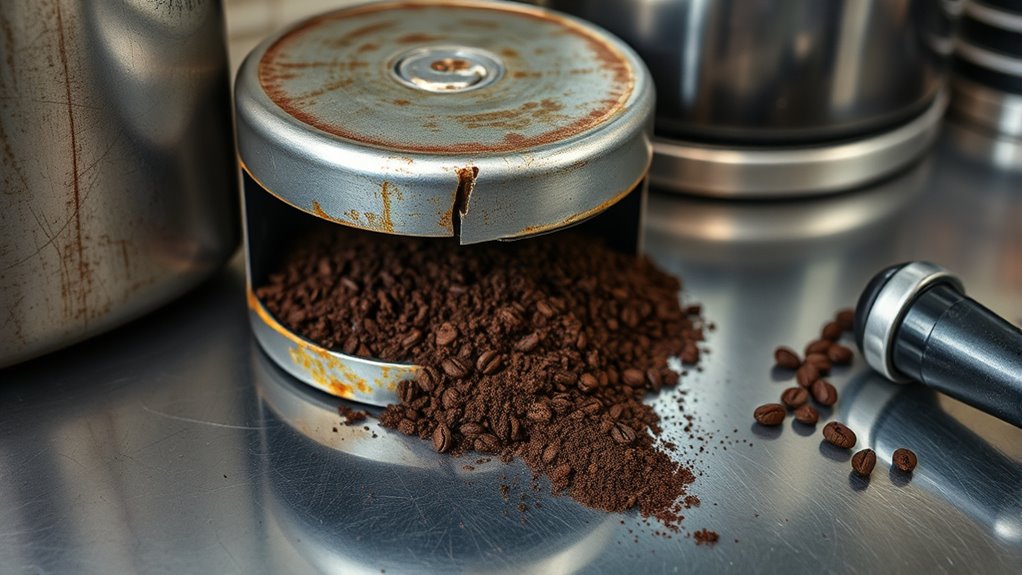
Even when a knock box seems to fit your needs, poor design can cause used grounds to spill or not sit securely. Fit issues often lead to grounds spillage, making cleanup more difficult and messy. If the opening is too small, you might struggle to empty grounds without causing a mess. Conversely, if it’s too large, grounds can fall out prematurely or cause excess spillage during use. Cheap knock boxes may have poorly constructed or mismatched parts, increasing the chance of grounds escaping. This not only creates a mess on your countertop but also wastes coffee grounds. Additionally, poor construction quality in inexpensive knock boxes can lead to breakage or deterioration over time, further compromising their effectiveness. To avoid these issues, choose a knock box with a properly sized opening and sturdy construction, ensuring grounds stay contained and your workspace remains tidy.
Noise Levels and Disruption During Use
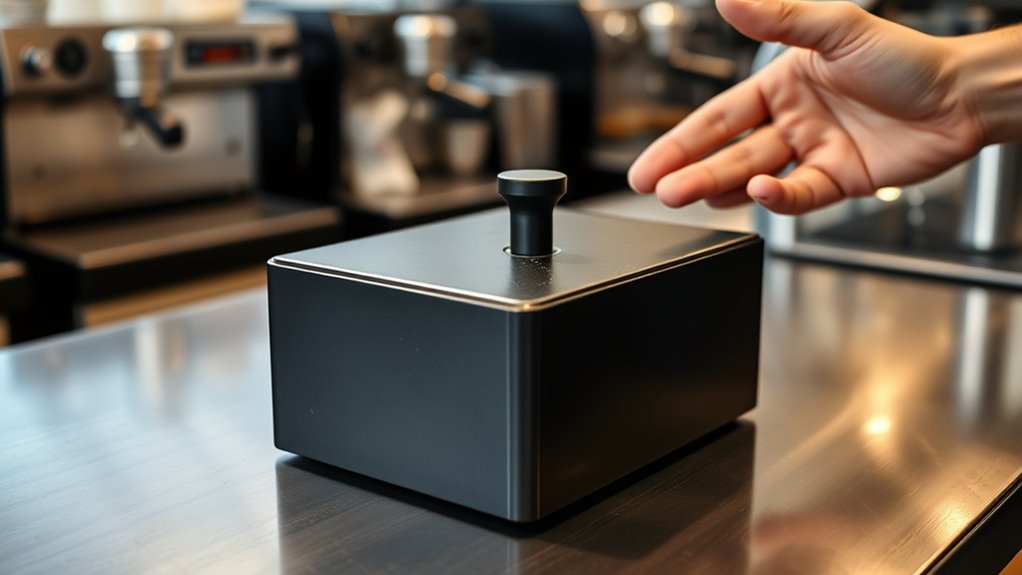
Cheap knock boxes often produce loud, disruptive noises during use, which can be especially bothersome in shared or quiet environments. The sound level generated when knocking out used grounds can be surprisingly high, causing user annoyance and disturbing others nearby. These boxes often lack sound-dampening features, so each tap resonates loudly, amplifying the disruption. If you work in a small coffee shop or share a space at home, this noise can become a constant source of frustration. Over time, the annoyance may lead you to avoid cleaning sessions altogether. Upgrading to a more solid, well-designed knock box or adding simple sound-absorbing materials can considerably reduce noise levels, making your workspace quieter and more comfortable. Additionally, choosing models with soundproofing features can lead to a more peaceful environment during daily use.
Stability and Risk of Tipping Over
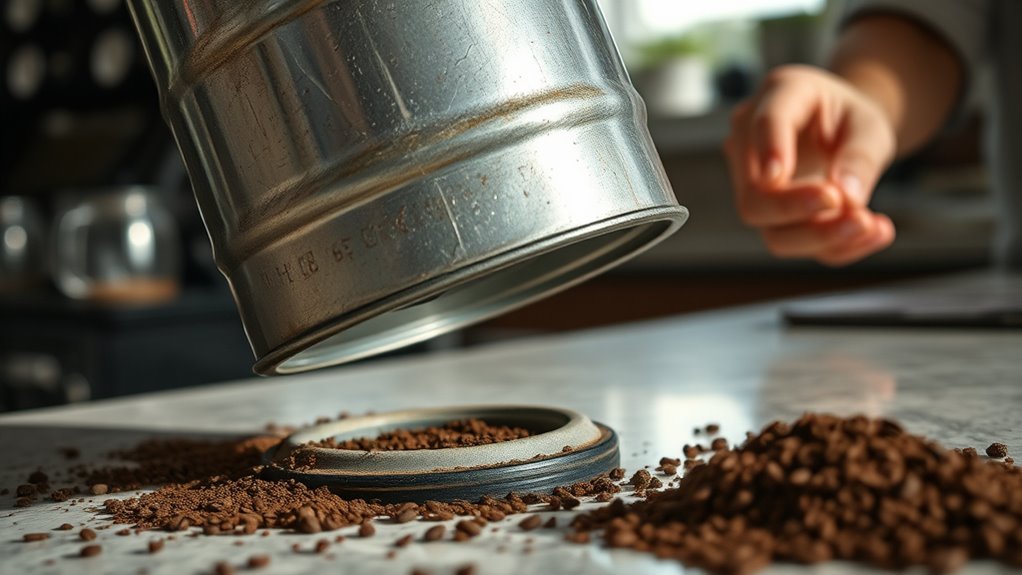
While noise can be a major concern, stability is another critical factor to contemplate when choosing a knock box. A poorly balanced knock box with uneven weight distribution can easily tip over, especially when you’re applying force during use. Many cheap models lack a solid, heavy base, which compromises base stability and makes tipping more likely. If the weight isn’t evenly distributed, even a slight bump or accidental nudge can cause it to fall. To avoid this, opt for a knock box with a weighted, low-profile base that anchors it firmly to your workspace. Proper weight distribution and a stable base ensure it stays put during use, reducing messes and potential accidents. Stability isn’t just about convenience—it’s about safety and efficiency. Additionally, selecting a knock box with appropriate materials can greatly enhance its durability and stability over time.
Limited Capacity and Workflow Bottlenecks
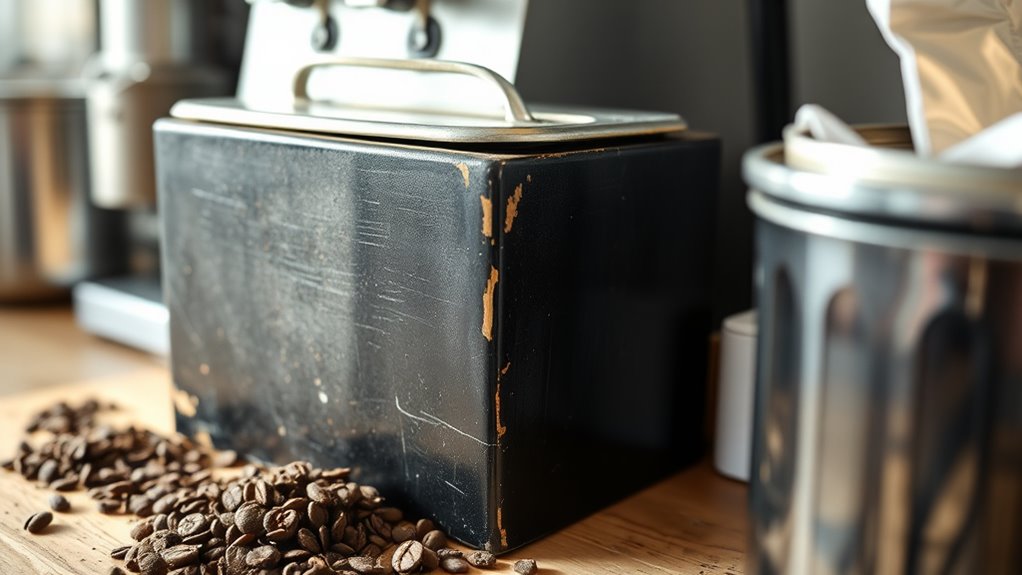
Limited capacity in knock boxes can quickly slow down your workflow, forcing you to pause frequently to empty or replace the container. These capacity limitations lead to workflow delays, especially during busy periods. If your knock box fills up quickly, you spend more time managing waste than brewing. To help you understand the impact, consider this table:
| Capacity Limitation | Workflow Delay | Solution |
|---|---|---|
| Small containers | Frequent emptying | Use larger boxes |
| Poor design | Bottlenecks | Upgrade materials |
| Inadequate drainage | Spills, messes | Opt for better models |
Addressing these issues ensures a smoother workflow and reduces delays, keeping your coffee station efficient and productive. Additionally, choosing high-quality materials for your knock box can enhance durability and reduce the need for frequent replacements.
Short-Lived Adhesives and Structural Failures
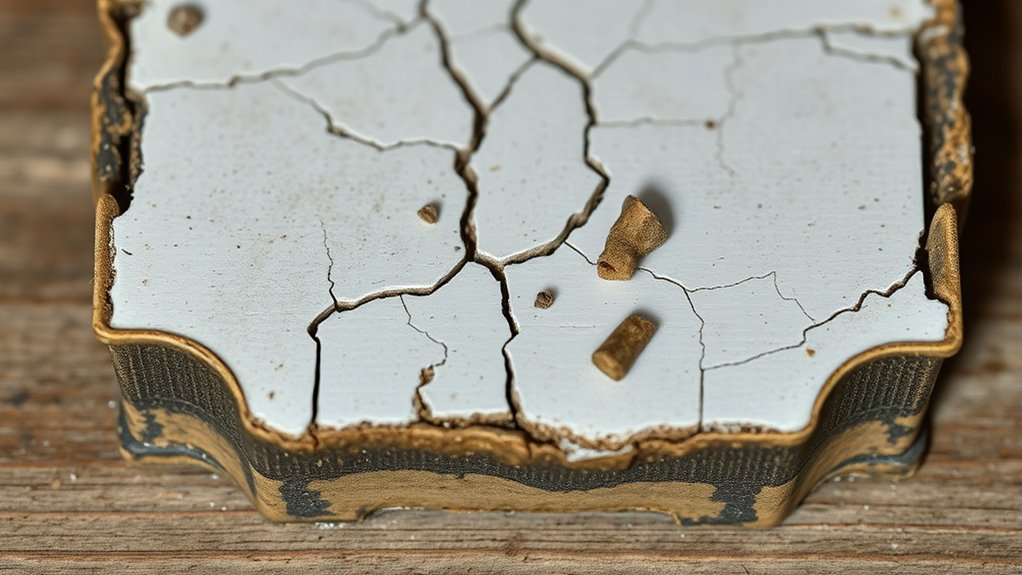
Short-lived adhesives and structural failures are common issues that arise when using low-quality knock boxes. Poor-quality adhesives often fail prematurely, leading to detachment of parts and compromised structural integrity. This means your knock box might not withstand regular use, causing it to break or wobble dangerously. When adhesives weaken, the entire structure becomes unstable, increasing the risk of breakage and safety hazards. Cheap materials and inferior bonding agents can’t handle the stress of daily use, resulting in adhesive failures over time. Additionally, materials quality plays a crucial role in the durability of the knock box, as subpar components are more prone to wear and failure. These issues not only shorten the lifespan of your knock box but also pose safety risks and disrupt your workflow. Investing in higher-quality adhesives and sturdy construction can considerably improve the durability and safety of your equipment.
Aesthetic and Ergonomic Shortcomings

Cheap knock boxes often look unattractive and clash with your workspace. They can also be uncomfortable to grip and handle, making your routine more frustrating. Plus, poor-quality materials tend to wear out quickly, worsening both form and function over time. Additionally, choosing a more durable beach-friendly design can help extend their lifespan and improve usability.
Unattractive Design Elements
Many budget knock boxes sacrifice aesthetic appeal and ergonomic comfort, making them less inviting and more difficult to use. Their dull, uninspired design elements detract from your workspace’s visual appeal, leaving it feeling cheap and unprofessional. Clunky shapes, plain finishes, and awkward proportions undermine your confidence in their quality. The table below captures the emotional impact of unattractive design elements:
| Design Flaw | Emotional Effect | User Impact |
|---|---|---|
| Dull, uninspired look | Decreases pride in your setup | Less motivation to use |
| Poor proportions | Feels awkward and unreliable | Difficult handling |
| Lack of visual appeal | Undermines workspace vibe | Less enjoyment |
Aesthetic shortcomings can turn a simple task into a frustrating experience, discouraging regular use. Additionally, ergonomic design is often overlooked in cheap knock boxes, which can lead to discomfort during extended use.
Uncomfortable Grip and Handling
Even if a knock box looks decent, uncomfortable grip and handling can make it frustrating to use. Many cheap knock boxes lack proper ergonomic design, which affects user comfort during daily use. Poorly shaped or slick surfaces can cause your hand to slip or strain as you hit and remove the container. This discomfort discourages proper technique and increases fatigue over time. A well-designed knock box should fit comfortably in your hand and provide a secure grip, reducing the effort needed and minimizing strain. When ergonomics aren’t prioritized, you risk hurting your hand or wrist, especially during repetitive use. Improving the grip, adding textured surfaces, or adjusting the height and angle can considerably enhance user comfort and make your coffee routine smoother and more enjoyable.
Poor Material Durability
When the materials used in a knock box are low quality, it can quickly lead to aesthetic and ergonomic issues that undermine its usefulness. Poor material durability affects both appearance and function, exposing design flaws and weakening material strength. Over time, the box may crack, chip, or warp, diminishing its look and making it less reliable. These flaws force you to replace or repair the knock box sooner than expected, adding costs and inconvenience. Here’s a quick comparison of common issues:
| Issue | Impact |
|---|---|
| Cracking | Reduced durability, unsafe handling |
| Chipping | Unsightly appearance, potential hazards |
| Warping | Poor fit, unstable use |
| Fading | Loss of aesthetic appeal |
| Material fatigue | Shortened lifespan |
Avoid cheap materials to ensure lasting strength and prevent design flaws.
Hidden Costs of Frequent Replacements

Frequent replacements of cheap knock boxes can quickly add up, revealing hidden costs that many overlook. When you ignore proper material selection, you might save money upfront but pay more in the long run. A poor cost analysis often leads to choosing low-quality options that break easily, forcing you to buy replacements often. Over time, these repeated purchases not only drain your budget but also waste time and effort. Cheaper knock boxes may seem like a bargain initially, but their fragility means you’re constantly replacing them. Investing in better materials from the start might cost more initially, but it pays off by extending the lifespan and reducing ongoing expenses. Ultimately, smart material selection helps you avoid the hidden costs associated with frequent, unnecessary replacements.
Simple Upgrades and DIY Fixes for Better Performance

Upgrading your knock box or performing simple DIY fixes can markedly boost its durability and performance without breaking the bank. One effective fix is adjusting your coffee grind; a finer grind increases clogs and strain, so using a slightly coarser grind can reduce stress on the knock box. Ensure your tamping pressure isn’t too heavy, which can cause excessive wear and damage. Reinforcing the knock box’s interior with a rubber liner or padding absorbs impact and prevents dents. Tightening loose bolts or replacing worn-out parts also enhances stability and longevity. Regularly cleaning and inspecting your knock box keeps it in top shape, preventing buildup that could compromise performance. With these straightforward upgrades and tweaks, you’ll enjoy smoother operation and longer-lasting equipment.
Frequently Asked Questions
Are There Eco-Friendly Options for Affordable Knock Boxes?
You wonder if there are eco-friendly options for affordable knock boxes. Luckily, you can find models made from biodegradable materials that break down naturally, reducing environmental impact. Recycled metal options are also available, giving new life to scrap materials and lowering waste. By choosing these sustainable materials, you support eco-conscious practices without sacrificing affordability, making your coffee routine greener and more responsible.
How Can I Prevent Ground Spillage During Use?
Imagine your knock box as a sturdy shield, stopping ground spillage in its tracks. To prevent messes during use, place a rubber mat underneath to catch stray grounds and drips. This simple barrier keeps your workspace clean and minimizes cleanup time. With a rubber mat, you create a dedicated, non-slip zone that contains any accidental ground spillage, making your coffee routine smoother and more enjoyable.
What Safety Precautions Should I Take With Cheap Knock Boxes?
When using cheap knock boxes, safety is key. Always wear safety gear like gloves to protect your hands, especially during knock box maintenance. Be cautious of sharp edges or broken parts that can cause injuries. Keep your workspace clean to prevent slips and spills. Regularly inspect your knock box for damage, and handle it carefully to avoid accidents. Proper maintenance and safety gear guarantee you stay safe while enjoying your coffee routine.
Can DIY Repairs Extend the Lifespan of Low-Cost Models?
Think of DIY repairs as a lifeline for your low-cost knock box, giving it new life. Yes, with the right repair tips and some elbow grease, you can extend its lifespan. Regular DIY maintenance helps prevent further damage and saves money. Just be cautious—if you’re unsure, consult a professional. Proper care turns your knock box into a resilient tool, ensuring it keeps knocking for years to come.
How Do I Choose a Budget-Friendly Knock Box for High-Volume Use?
When choosing a budget-friendly knock box for high-volume use, focus on material durability and size considerations. Opt for a model made from sturdy materials like stainless steel, which withstands heavy use better. Confirm the size fits your workspace and volume needs; a larger box reduces frequent emptying and minimizes wear. Balancing durability and capacity helps you find an affordable option that performs well under high-volume demands.
Conclusion
Remember, you get what you pay for. Cheap knock boxes might seem like a bargain, but they often cost you more in the long run with frequent replacements and ongoing frustrations. By investing in quality or making simple upgrades, you can avoid the hidden drawbacks and enjoy a smoother, more reliable experience. Don’t let shortcuts compromise your coffee routine—sometimes, a small upgrade is worth a thousand regrets.


